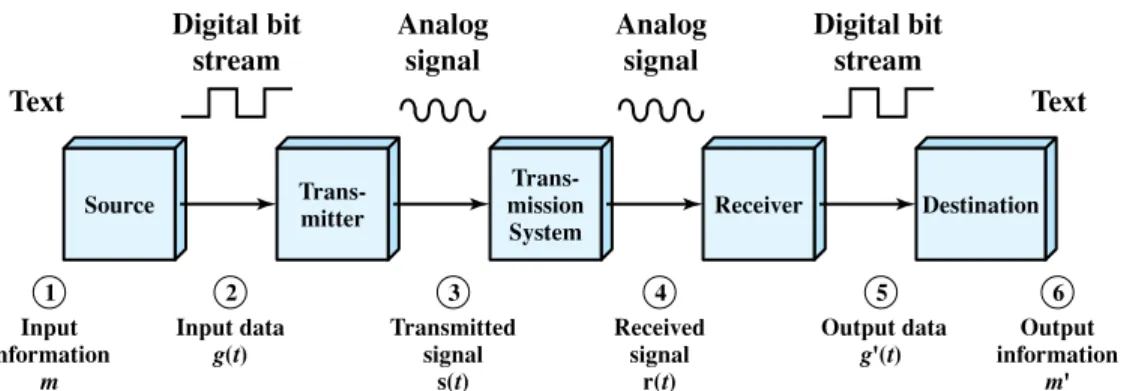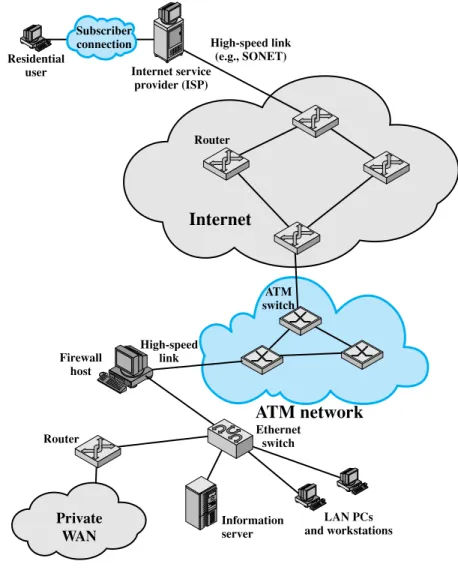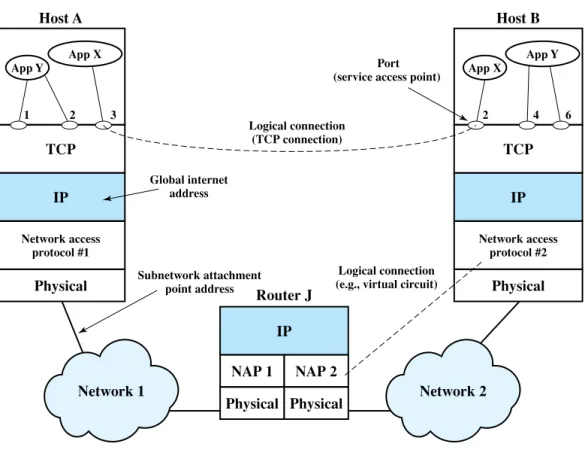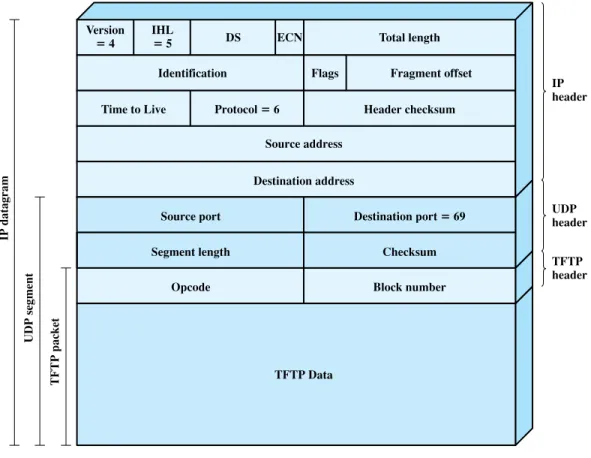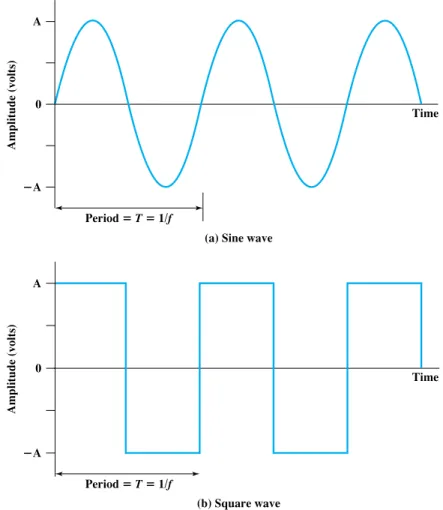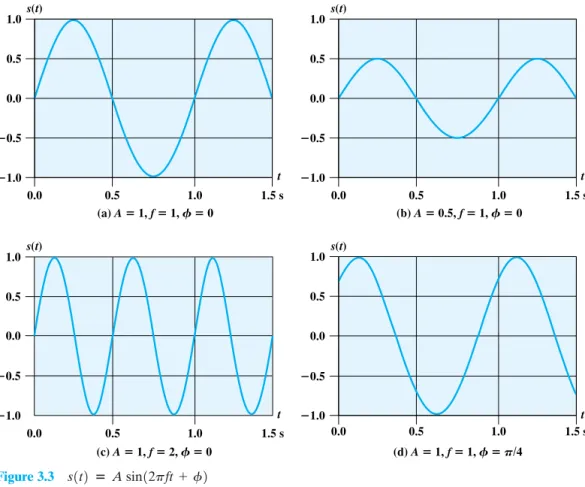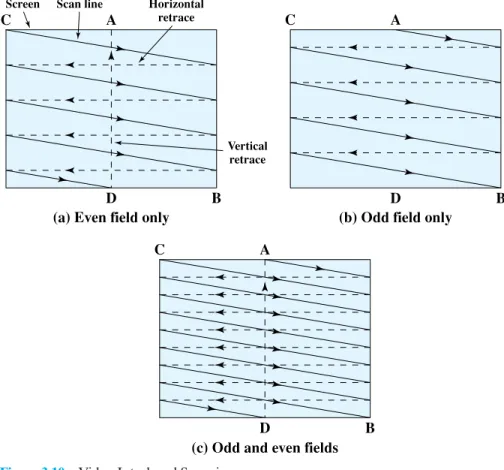The author and publisher have put a lot of effort into preparing this book. These efforts include the development, research, and testing of theories and programs to determine their effectiveness. The author and publisher make no warranties of any kind, express or implied, with respect to these programs or the documentation in this book. In no event shall the author and publisher be liable for incidental or consequential damages in connection with or arising from the supply, operation or use of these programs. The DCC8e website includes links to websites for courses taught using the book.
Internet Applications—Electronic Mail and Network Management 743 22.1 Electronic Mail: SMTP and MIME 745
Internet Applications—Internet Directory Service and World Wide Web 773 23.1 Internet Directory Service: DNS 774
V.24/EIA-232-F G.2 ISDN Physical Interface
Queuing Effects I.1 Queuing Models
P REFACE
OBJECTIVES
INTENDED AUDIENCE
PLAN OF THE TEXT
In addition, the book contains an extensive glossary, a list of frequently used acronyms and a bibliography. See Chapter 0 for a number of detailed suggestions for both top-down and bottom-up course strategies.
INSTRUCTIONAL SUPPORT MATERIALS
The chapters and sections of the book are modular enough to provide a great deal of flexibility in course design.
INTERNET SERVICES FOR INSTRUCTORS AND STUDENTS
PROJECTS AND OTHER STUDENT EXERCISES
Research Projects: The instructor's supplement contains a list of proposed research projects requiring an internet and literature search. Writing Assignments: The teacher's supplement contains a list of writing assignments to facilitate learning the material.
WHAT’S NEW IN THE EIGHTH EDITION
Reading/Reporting Assignments: The teacher's supplement contains a list of papers that can be assigned for reading and writing a report, plus suggested assignment wordings. This diverse set of projects and other student exercises allows the instructor to use the book as part of a rich and varied learning experience and to tailor a course plan to meet the specific needs of the instructor and students.
ACKNOWLEDGMENTS
New coverage of IP performance metrics and service level agreements (SLAs): These aspects of Quality of Service (QoS) and performance monitoring are becoming increasingly important. New coverage of TCP Tahoe, Reno, and NewReno: These congestion control algorithms are now common in most commercial implementations.
CHAPTER
R EADER ’ S AND I NSTRUCTOR ’ S G UIDE
OUTLINE OF THE BOOK
This part provides a general overview of data communications and networking and a discussion of protocols, OSI and the TCP/IP protocol suite. Data communication: deals primarily with the exchange of data between two directly connected devices. Within this limited area, the key aspects of transmission, interfacing, link control and multiplexing are examined.
Course Emphasis
Bottom-Up versus Top-Down
INTERNET AND WEB RESOURCES
Web Sites for This Book
Other Web Sites
IEEE Communications Society: Good way to keep up with conferences, publications, and so on. ACM Special Interest Group on Communications (SIGCOMM): Good way to keep up with conferences, publications, and so on.
USENET Newsgroups
STANDARDS
As a result, standards now permeate all the technology areas covered in this book. This is not a weakness of the standards themselves, but of the current way of working.
P ART O NE
Overview
ROAD MAP FOR PART ONE
Data Communications, Data Networks, and The Internet
Protocol Architecture, TCP/IP, and Internet-Based Applications
D ATA C OMMUNICATIONS , D ATA N ETWORKS , AND THE I NTERNET
One effect of these trends has been a growing overlap of the computing and communications industries, from component manufacturing to system integration. This book aims to provide a comprehensive overview of the broad field of data and computer communications.
KEY POINTS
DATA COMMUNICATIONS AND NETWORKING FOR TODAY’S ENTERPRISE
Trends
1 Briefly, an intranet uses internet and web technology in an isolated facility internal to a company; an extranet extends a company's intranet onto the Internet to give selected customers, suppliers and mobile employees access to the company's private data and applications. In addition to leveraging the Internet and the Internet to reach customers, suppliers, and partners, companies have formed intranets and extranets1 to isolate their proprietary information free from unwanted access.
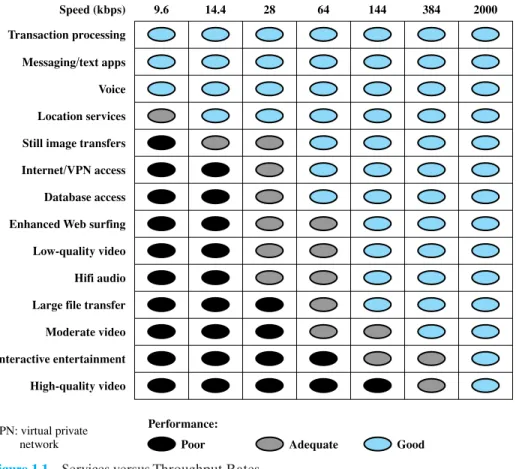
Data Transmission and Network Capacity Requirements
A COMMUNICATIONS MODEL
The characteristics of the signal, such as shape and intensity, must be such that the signal (1) is capable of being propagated through the transmission system and (2) can be interpreted as data at the receiver. Message formatting has to do with an agreement between two parties about the form of the data to be exchanged or transmitted, such as the binary code for characters.
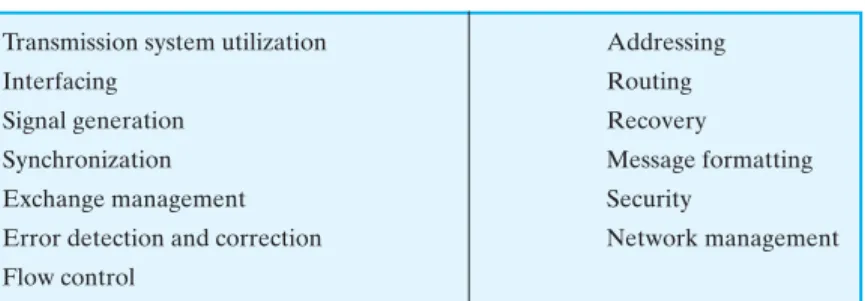
A Data Communications Model
The message as seen by the user will usually be an exact copy of the original message (m). The sound waves are converted by the phone into electrical signals of the same frequency.
The Transmission of Information
NETWORKS
As the number and power of computing devices increases, so does the number and capacity of LANs in the office. Although standards have been developed that somewhat reduce the number of types of local area networks, there are still half a dozen general types of local area networks available.
Wide Area Networks
While the original packet-switched networks were designed with an end-user data rate of around 64 kbps, frame relay networks are designed to operate efficiently at end-user data rates of up to 2 Mbps. Asynchronous transfer mode ATM (ATM), sometimes referred to as cellular relay, is a culmination of developments in circuit switching and packet switching.
Local Area Networks
By using small, fixed-size cells, ATM is so efficient that it can provide a constant data rate channel even though it uses a packet-switching technique. Thus, ATM extends circuit switching to allow multiple channels with the data rate on each channel set dynamically on demand.
Wireless Networks
24 CHAPTER 1 / DATA COMMUNICATION, DATA NETWORKS AND THE INTERNET reliability of the transmission system and on higher logic layers in the end systems to catch and correct errors. The result is that ATM is designed to work in the 10s and 100s Mbps range and in the Gbps range.
Origins of the Internet
Key Elements
Internet Architecture
AN EXAMPLE CONFIGURATION
The NSP equipment is responsible for routing and the NAP infrastructure provides the physical access paths between routers. His computer can now communicate and share resources with any other computer connected to the larger ISP network.
Internet
ATM network
The LAN connects to the Internet through a firewall host that provides security services. A number of design issues, such as signal coding and error control, are related to connections between adjacent elements, such as between Internet routers or between switches in the ATM network, or between a subscriber and an ISP.
P ROTOCOL A RCHITECTURE , TCP/IP,
NTERNET -B ASED A PPLICATIONS
THE NEED FOR A PROTOCOL ARCHITECTURE
A protocol architecture is the layered structure of hardware and software that supports the exchange of data between systems and supports distributed applications, such as electronic mail and file transfer. The most widely used protocol architecture is the TCP/IP protocol suite, which consists of the following layers: physical, network access, Internet, transport and application.
THE TCP/IP PROTOCOL ARCHITECTURE
The file transfer application on the source system must ascertain that the file manager on the destination system is prepared to accept and store the file for this particular user. If the file formats used in the two systems are different, one or the other system must perform a format translation function.
The TCP/IP Layers
The sending computer must provide the network with the address of the destination computer so that the network can route the data to the appropriate destination. The same higher-level software should work correctly regardless of the specific network to which the computer is connected.
Operation of TCP and IP
Each host on a subnet must have a unique global Internet address; this allows the data to be delivered to the correct host. IP then delivers the message to the network access layer (eg, Ethernet logic) with instructions to send it to router J (the first hop on the path to B).
TCP and UDP
Based on the destination address information in the IP header, the IP module in the router sends the datagram over subnet 2 to B. UDP also contains a checksum to verify that no error occurs in the data; using the checksum is optional.
IP and IPv6
But the driving force behind the development of the new protocol was the need for more addresses. With the explosive growth of the Internet and Internet-connected private networks, this address length became insufficient to accommodate all the systems that needed addresses.
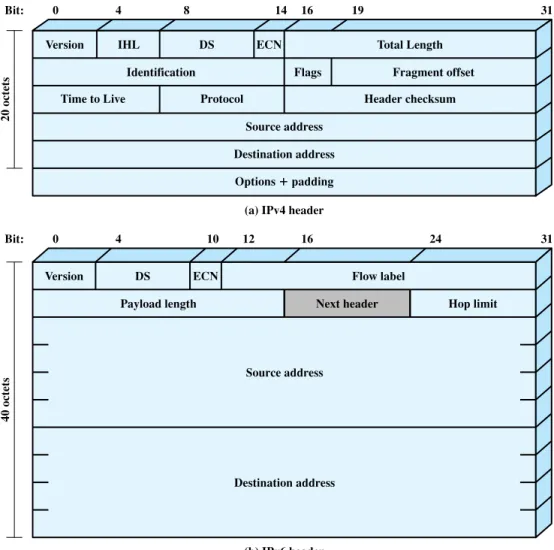
TCP/IP Applications
THE OSI MODEL
Instead, the TCP/IP architecture has come to dominate. There are a number of reasons for this result. Another reason is that the OSI model is too complex, with seven layers to accomplish what TCP/IP does with fewer layers.
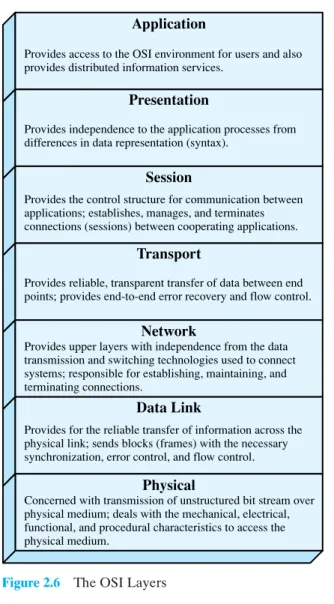
STANDARDIZATION WITHIN A PROTOCOL ARCHITECURE
Standardization within the OSI Framework 3
Each layer provides services to the next higher layer and implements a protocol for the peer layer in other systems. Service definition: In addition to the protocol or protocols operating at a particular layer, standards are needed for the services each layer provides to the next higher layer.
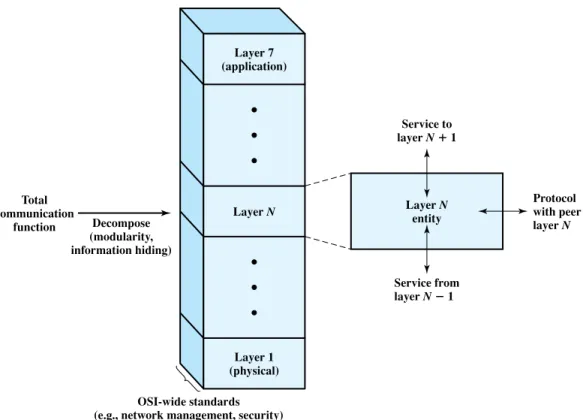
Service Primitives and Parameters
Regarding service definitions, the motivation for providing only a functional definition is as follows. With regard to addressing, the use of an addressing mechanism at each layer, implemented as a service access point, enables each layer to multiplex multiple users from the next higher layer.
Layer N
TRADITIONAL INTERNET-BASED APPLICATIONS
File Transfer Protocol (FTP) is used to send files from one system to another under user command. After a file transfer is approved, a second TCP connection is established to transfer the data.
MULTIMEDA
When a user wants to participate in file transfer, FTP establishes a TCP connection to the target system to exchange control messages. Server TELNET interacts with an application and acts as a surrogate terminal handler so that remote terminals appear local to the application.
Media Types
However, the term is often used in a broader sense of data that can be stored in files and databases and does not fall into the other three categories. In the raster graphics format, the image is represented as a two-dimensional array of dots called pixels.4 The compressed JPG format is derived from the raster graphics format.
Multimedia Applications
4A pixel, or picture element, is the smallest element of a digital image that can be assigned a gray level. Images can be represented in a vector graphics format, such as is used in drawing programs and PDF files.
Elastic and Inelastic Traffic
Real-time interactive applications, such as teleconferencing, may require a reasonable upper bound on delay variation. A second requirement for supporting inelastic traffic in an Internet architecture is that elastic traffic must still be supported.
Multimedia Technologies
RECOMMENDED READING AND WEB SITES
Two early papers that provide good discussions of the design philosophy of the TCP/IP protocol suite are [LEIN85] and [CLAR88]. STEV96 Stevens, W.TCP/IP Illustrated Volume 3: TCP for Transactions, HTTP, NNTP, and the UNIX(R) Domain Protocol. Reading, MA: Addison-Wesley, 1996.
Recommended Web sites: 5
KEY TERMS, REVIEW QUESTIONS, AND PROBLEMS Key Terms
Review Questions
Problems
How many bits, including headers, are delivered to the network layer protocol at the destination. To do this, it transfers the file using TFTP using the netascii transfer method.
APPENDIX 2A THE TRIVIAL FILE TRANSFER PROTOCOL
Introduction to TFTP
TFTP Packets
An ACK of a data packet contains the block number of the data packet being acknowledged. If the file transfer is not complete, each ACK packet from one side is followed by a data packet from the other, so that the data packet functions as an acknowledgment.
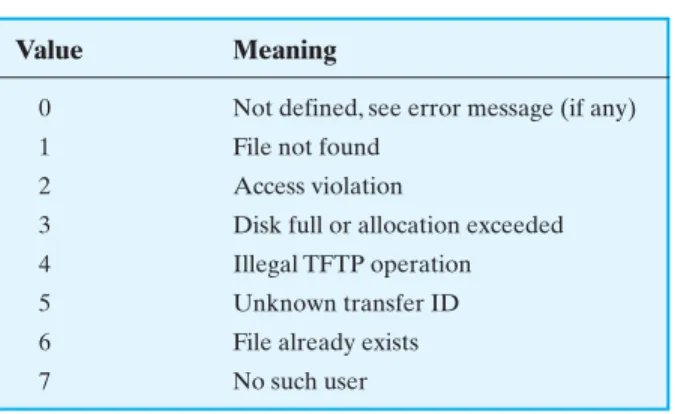
Overview of a Transfer
When such a packet is passed to UDP, UDP appends a header to form a UDP segment. This is then passed to IP, which adds an IP header to form an IP datagram.
Errors and Delays
Syntax, Semantics, and Timing
P ART T WO
Data Communications
ROAD MAP FOR PART TWO
- Data Transmission
- Transmission Media
- Signal Encoding Techniques
- Digital Data Communication Techniques
- Data Link Control Protocols
- Multiplexing
- Spread Spectrum
True cooperative digital data exchange between two devices requires some form of data link control. It often happens that two communication stations will not use the full capacity of a data link.
D ATA T RANSMISSION
CONCEPTS AND TERMINOLOGY
The main defects are damping, mental distortion, delay distortion and various forms of noise.
Transmission Terminology
Frequency, Spectrum, and Bandwidth
ANALOG AND DIGITAL DATA TRANSMISSION
These two terms are often used in data communications in at least three contexts: data, signaling, and transmission. In what follows, we try to make these abstract concepts clear by discussing the terms analog and digital as applied to data, signals and transmission.
Analog and Digital Data
At the end of each scan line, the beam is quickly fed back to the left (horizontal retracement). When the jet reaches the bottom, it is quickly swept back to the top (vertical return).
![Figure 3.9 Acoustic Spectrum of Speech and Music [CARN99a]](https://thumb-ap.123doks.com/thumbv2/filepdfnet/10311646.0/98.704.131.634.89.420/figure-acoustic-spectrum-speech-music-carn-a.webp)
Analog and Digital Signals
To do this we need to estimate the upper (maximum) and lower (minimum) frequency of the band. Digital data can be represented by digital signals, with a different voltage level for each of the two binary digits.

Analog and Digital Transmission
TRANSMISSION IMPAIRMENTS
With any communication system, the received signal can differ from the transmitted signal due to various transmission impairments. In this section, we examine the various impairments and how they can affect the information carrying capacity of a communication link; Chapter 5 examines measures that can be taken to offset these impairments.
Attenuation
As can be seen, the frequency components at the upper end of the vocal band are much more attenuated than those at lower frequencies. It should be clear that this will cause distortion of the received speech signal.
Delay Distortion
This is usually done for voice-quality telephone lines by using charging coils that change the electrical characteristics of the line; the result is to smooth out attenuation effects. As we have seen, the strength of a digital signal decreases rapidly with frequency (Figure 3.5b); most content is concentrated near the fundamental frequency or bit rate of the signal.
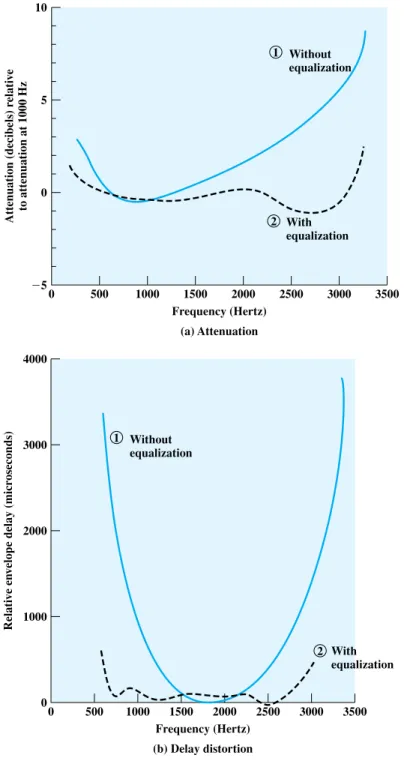
Noise
CHANNEL CAPACITY
The digital data can be extracted from the signal by sampling the received waveform once per bit time. Data Rate: The rate, in bits per second (bps), at which data can be communicated.
Nyquist Bandwidth
Bandwidth: The bandwidth of the transmitted signal as limited by the transmitter and the nature of the transmission medium, expressed in cycles per second, or Hertz. Limitations arise from the physical properties of the transmission medium or from intentional limitations on the transmitter's bandwidth to prevent interference from other sources.
Shannon Capacity Formula
Also, in some cases the dimensionless quantity is referred to as SNR or S/N and the quantity in decibels is referred to as or Others just use SNR or S/N to mean the dB quantity. The capacity indicated in the preceding equation is referred to as the fault-free capacity.
The Expression
RECOMMENDED READING AND WEB SITE
Recommended Web site
KEY TERMS, REVIEW QUESTIONS, AND PROBLEMS Key Terms
What would the signal look like in the opposite case; that is, retaining all higher harmonics and eliminating some lower harmonics. In the 1970s, many newspapers received stories from the wire services in a 6-bit code called TTS.
APPENDIX 3A DECIBELS AND SIGNAL STRENGTH
For example, a gain means that the power is halved, and this is a loss of power. EXAMPLE 3.7 If a signal with a power level of 10 mW is inserted on a transmission line and the measured power some distance away is 5 mW, the loss can be expressed as
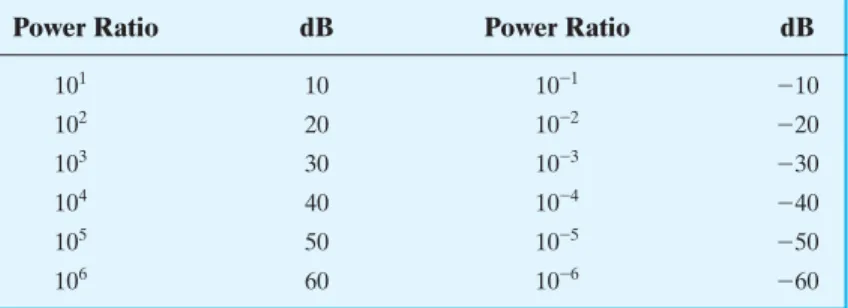
T RANSMISSION M EDIA
GUIDED TRANSMISSION MEDIA
For guided transmission media, the transmission capacity, in terms of data rate or bandwidth, depends critically on the distance and whether the medium is point-to-point or multipoint. The three routed media commonly used for data transmission are twisted pair, coaxial cable, and fiber optics (Figure 4.2).
Twisted Pair
Twisted pair is also commonly used in a building for local area networks that support PCs. For long haul applications, twisted pair can be used at data rates of 4 Mbps or more.
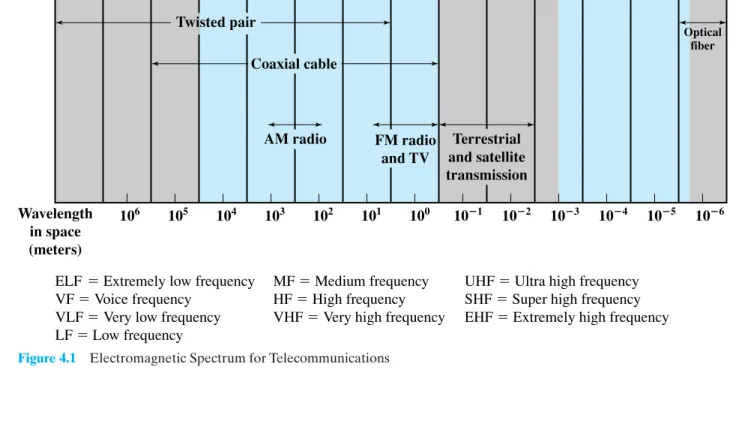
Coaxial Cable
Optical Fiber
Repeater spacing in the tens of kilometers for optical fiber is common, and repeater spacing of hundreds of kilometers has been demonstrated. Both are semiconductor devices that emit a beam of light when a voltage is applied. The LED is cheaper, works over a wider temperature range and has a longer operating life. The ILD, which works on the laser principle, is more efficient and can sustain higher data rates.
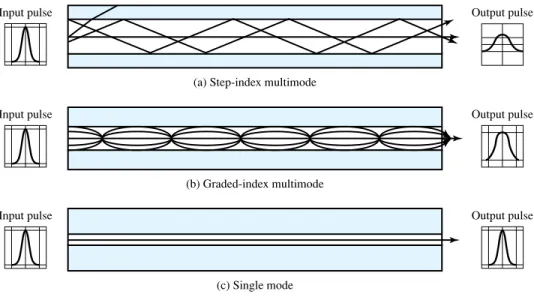
Antennas
The effective area of an antenna is related to the physical size of the antenna and its shape. For example, the effective area of an ideal isotropic antenna is with a power gain of 1; effective area of a parabolic antenna with an area of Ais 0.56A, with a power gain of 7A/l2.
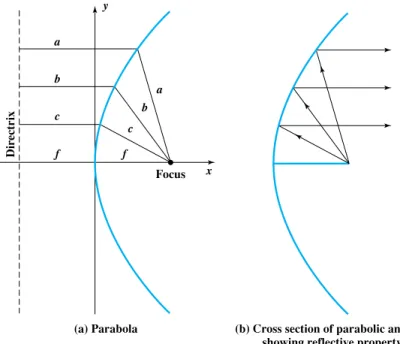
Terrestrial Microwave
EXAMPLE 4.2 For a 2 m diameter parabolic reflector antenna operating at 12 GHz, what is the effective area and gain of the antenna. The higher the frequency used, the higher the potential bandwidth and therefore the higher the potential data rate.
Satellite Microwave
In the first, the satellite is used to provide a point-to-point connection between two distant ground-based antennas. Transmission characteristics The optimal frequency range for satellite transmission is in the range of 1 to 10 GHz.
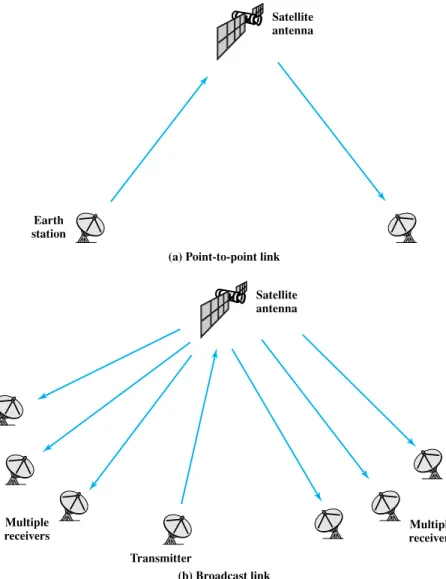
Broadcast Radio
This band experiences even greater attenuation problems, but will allow greater bandwidth (2500 MHz versus 500 MHz) and even smaller and cheaper receivers. First, because of the long distances involved, there is a propagation delay of about a quarter of a second from transmission by one earth station to reception by another earth station.
Infrared
WIRELESS PROPAGATION
Ground Wave Propagation
Sky Wave Propagation
Line-of-Sight Propagation
The amount and even the direction of the bending depends on the conditions, but microwaves are generally bent by the curvature of the earth and will therefore propagate further than the optical line of sight. The refractive index is also the same as the ratio of the velocities in the two media.
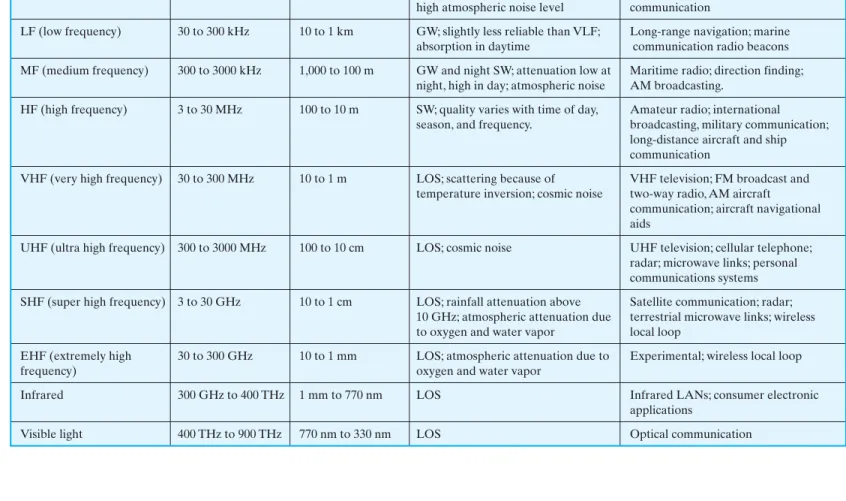
Earth
LINE-OF-SIGHT TRANSMISSION
So a good rule of thumb is that the maximum distance between two antennas for LOS propagation is the height of the two antennas. EXAMPLE 4.3 The maximum distance between two antennas for LOS transmission if one antenna is 100 m high and the other is at ground level.
Free Space Loss
3As noted in Appendix 3A, there is some inconsistency in the literature regarding the use of the terms profit and loss. Ar = effective area of the receiving antenna At = effective area of the transmitting antenna Gr = gain of the receiving antenna.
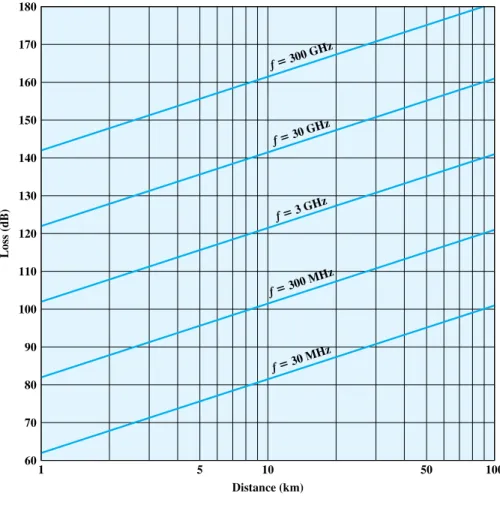
Atmospheric Absorption
Multipath
Refraction
RECOMMENDED READING AND WEB SITES
STAL00 Stallings, W.Local and Metropolitan Area Networks, Sesde Uitgawe.Upper Saddle River, NJ: Prentice Hall, 2000.
Recommended Web sites
KEY TERMS, REVIEW QUESTIONS, AND PROBLEMS Key Terms
First show that tan Hint: Remember from trigonometry that the slope of a line is equal to the tangent of the angle the line makes with the positive x-direction. Considering antenna gain, what is the effective radiated power of the transmitted signal.
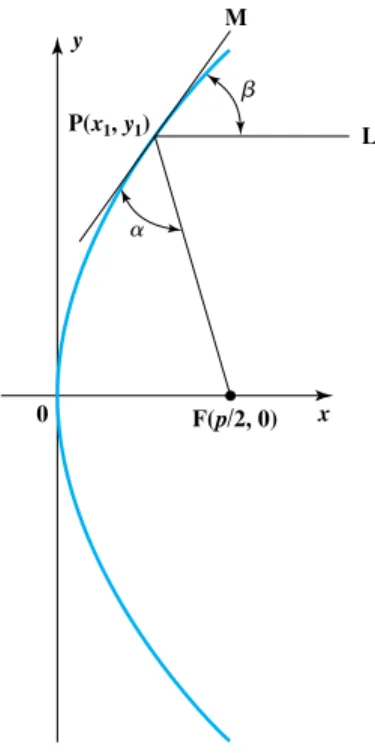
S IGNAL E NCODING T ECHNIQUES
DIGITAL DATA, DIGITAL SIGNALS
In Figure 3.16, these tasks are performed by sampling each bit position in the middle of the interval and comparing the value to a threshold. Therefore, a good signal design must concentrate the transmitted power in the middle of the transmission bandwidth.
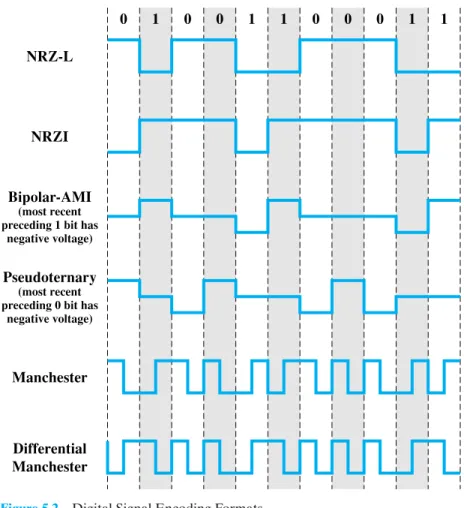
Nonreturn to Zero (NRZ)
Signal interference and noise immunity: Certain codes perform superiorly in the presence of noise. For example, if an NRZ code is used to generate a signal with a data rate of 9600 bps, most of the energy in the signal is concentrated between DC and 4800 Hz.
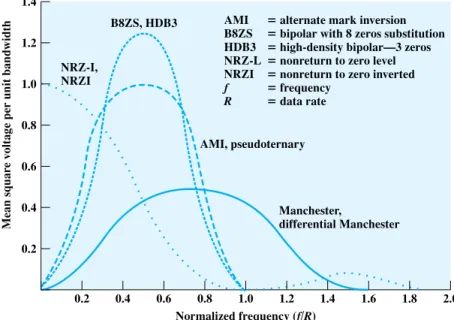
Multilevel Binary
Biphase
The more common Manchester code was specified for the IEEE 802.3 (Ethernet) standard for baseband coaxial cables and twisted-pair LAN buses. Differential Manchester was specified for IEEE 802.5 token ring LAN using shielded twisted pair.
Modulation Rate
As shown in Figure 5-3, the bandwidth for biphase codes is fairly narrow and contains no dc component. It indicates the signal transition rate in the case of a data stream of alternating 1s and 0s, and for the data stream producing the minimum and maximum modulation rate.
Scrambling Techniques
DIGITAL DATA, ANALOG SIGNALS
Most of the energy is concentrated in a relatively sharp spectrum around a frequency equal to half the data rate. This section introduces these techniques and provides a brief discussion of the performance characteristics of alternative approaches.
Amplitude Shift Keying
The most familiar use of this transformation is for the transmission of digital data over the public telephone network. We mentioned that modulation involves operation on one or more of the three characteristics of a carrier signal: amplitude, frequency and phase.
Frequency Shift Keying
That is, one signal element is represented by a light pulse, while the other signal element is represented by the absence of light. This low level represents one signal element, while a higher amplitude light wave represents another signal element.
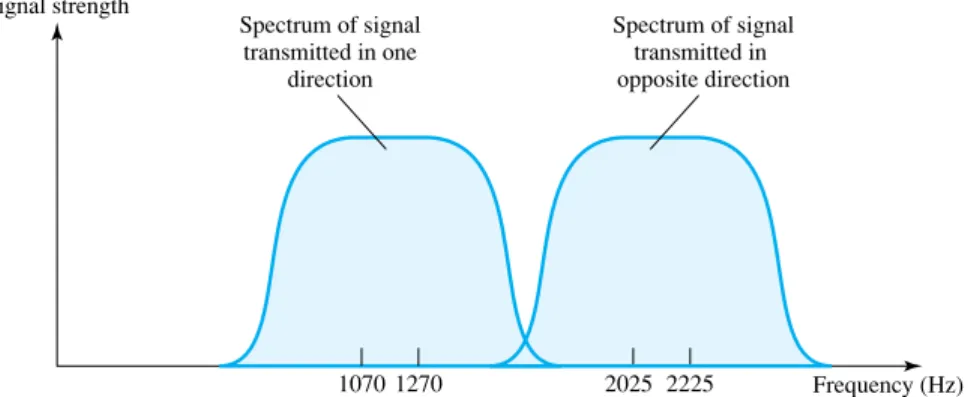
Phase Shift Keying
The display in the figure shows the transmitted frequency (y-axis) as a function of time (x-axis). Each of the two modulated streams is a BPSK signal at half the data rate of the original bit stream.
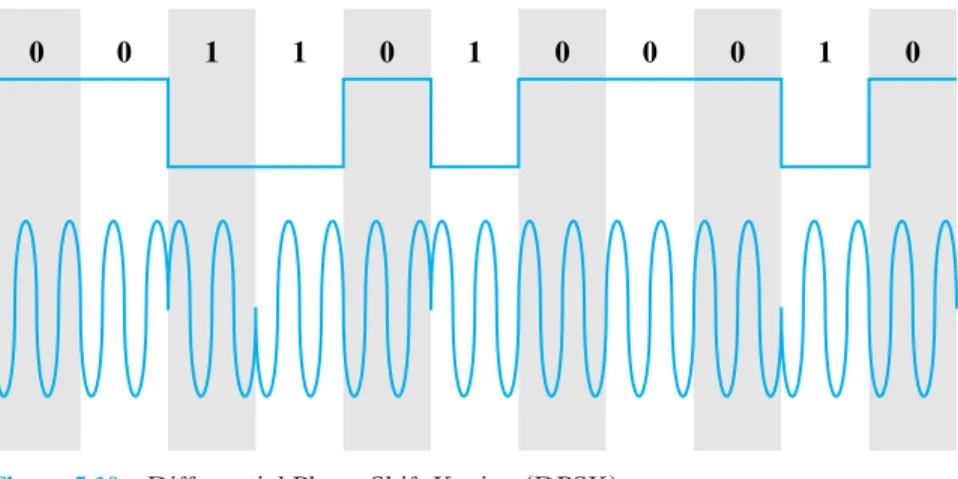
Performance
EXAMPLE 5.3 What is the bandwidth efficiency of FSK, ASK, PSK, and QPSK for a channel bit error rate of 12 dB SNR. As the previous example shows, ASK and FSK have the same bandwidth efficiency, PSK is better, and even greater improvement can be achieved with multi-level signaling.
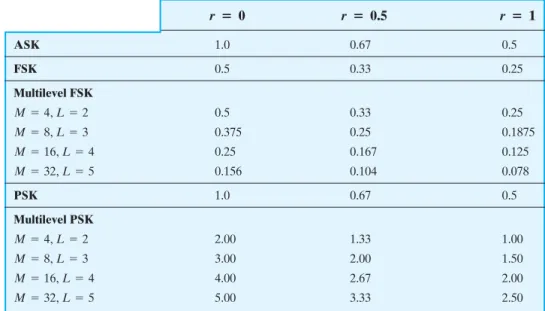
Quadrature Amplitude Modulation
ANALOG DATA, DIGITAL SIGNALS
In this section, we examine the process of transforming analog data into digital signals. Strictly speaking, it may be more correct to refer to this as a process of converting analogue data into digital data; this process is known as digitization.
Pulse Code Modulation
PCM thus starts with a continuous-time, continuous-amplitude (analogue) signal, from which a digital signal is produced (Figure 5.17). By using a larger number of quantization steps for low-amplitude signals and a smaller number of quantization steps for large-amplitude signals, a significant reduction in overall signal distortion is achieved (see, for example, Figure 5.18).
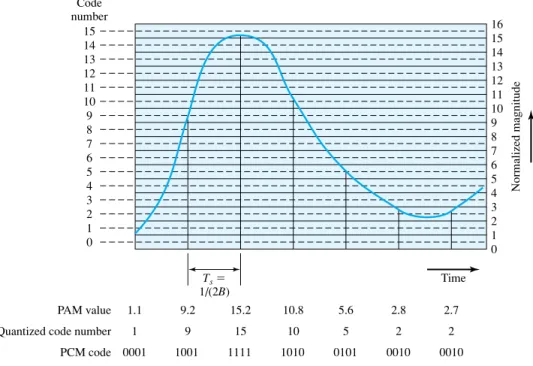
Delta Modulation (DM)
ANALOG DATA, ANALOG SIGNALS
Modulation has been defined as the process of combining an input signal m(t) and a carrier wave at frequency to produce a signal s(t) whose bandwidth is (usually) centered. For digital data, the motivation for modulation should be clear. : When only analog transmission facilities are available, modulation is required to convert the digital data into analog form. In this section, we look at the main techniques for modulation using analog data: amplitude modulation (AM), frequency modulation (FM), and phase modulation (PM).
Amplitude Modulation
A popular variant of AM, known as single sideband (SSB), takes advantage of this fact by transmitting only one of the sidebands, eliminating the other sideband and the carrier. Less power is required because no power is used to transmit the carrier or the other sideband.
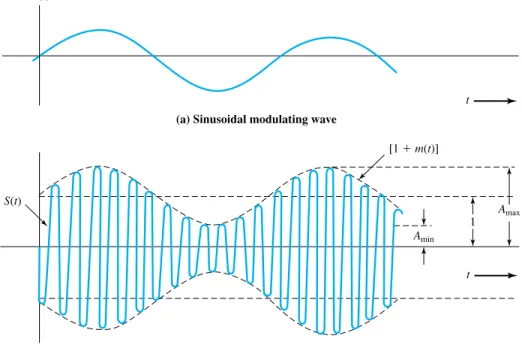
Angle Modulation
RECOMMENDED READING
Solid treatments of digital-to-digital coding systems are for some reason hard to find. Good choices are [COUC01], [XION00] and [PROA05]; these three also provide a comprehensive treatment of digital and analog modulation schemes for analog data.
KEY TERMS, REVIEW QUESTIONS, AND PROBLEMS
A recommended tutorial that expands on the concepts covered in the past few chapters related to bandwidth efficiency and encoding schemes is [SKLA93].
Key Terms
Assume that the signal level for the preceding bit for NRZI was high; the most recent preceding 1 bit (AMI) has a negative voltage; and the most recent preceding 0 bit (pseudoternary) has a negative voltage. Assume that a sampling rate of 7000 samples per second will be used to generate a PCM signal.
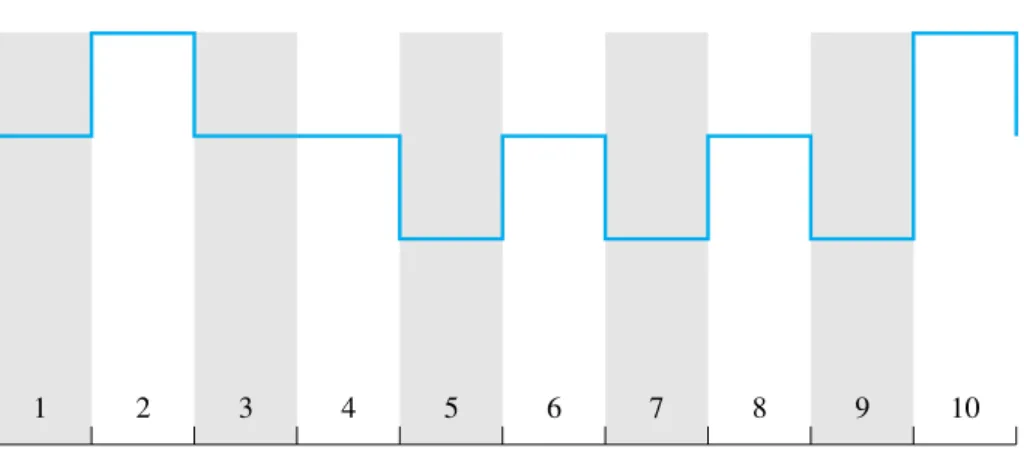
D IGITAL D ATA C OMMUNICATION
T ECHNIQUES
